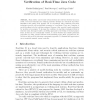Free Online Productivity Tools
i2Speak
i2Symbol
i2OCR
iTex2Img
iWeb2Print
iWeb2Shot
i2Type
iPdf2Split
iPdf2Merge
i2Bopomofo
i2Arabic
i2Style
i2Image
i2PDF
iLatex2Rtf
Sci2ools
CADE
2008
Springer
2008
Springer
Exploring Model-Based Development for the Verification of Real-Time Java Code
Many safety- and security-critical systems are real-time systems and, as a result, tools and techniques for verifying real-time systems are extremely important. Simulation and testing such systems can be exceedingly time-consuming and these techniques provide only probabilistic measures of correctness. There are a number of model-checking tools for real-time systems. However, they provide formal verification for models, not programs. To increase the confidence in real-time programs written in real-time Java, this paper takes a modelling approach to the design of such programs. First, models can be mechanically verified, to check whether they satisfy particular properties, by using current real-time model-checking tools. Then, programs are derived from the model by following a systematic approach. To illustrate the approach we use a nontrivial example: a gear controller.
Automated Reasoning | CADE 2008 | Current Real-time Model-checking | Model-checking Tools | Real-time Systems |
| Added | 03 Dec 2009 |
| Updated | 03 Dec 2009 |
| Type | Conference |
| Year | 2008 |
| Where | CADE |
| Authors | Niusha Hakimipour, Paul A. Strooper, Roger Duke |
Comments (0)

